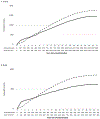Effect of flexible sigmoidoscopy screening on colorectal cancer incidence and mortality: long-term follow-up of the randomised US PLCO cancer screening trial
- PMID: 30502933
- PMCID: PMC6335177
- DOI: 10.1016/S2468-1253(18)30358-3
Effect of flexible sigmoidoscopy screening on colorectal cancer incidence and mortality: long-term follow-up of the randomised US PLCO cancer screening trial
Abstract
Background: Screening flexible sigmoidoscopy reduces incidence and mortality of colorectal cancer. Previously reported results from the Prostate, Lung, Colorectal, and Ovarian Cancer (PLCO) screening trial had a median follow-up of 12 years. Whether the benefit is sustained over the long term and remains so in both sexes and all age groups is uncertain. We report long-term results after an additional 5 years of follow-up.
Methods: Participants in the PLCO trial were recruited from the general population in the catchment areas of ten screening centres across the USA, without previous diagnosis of a prostate, lung, colorectal, or ovarian cancer or current cancer treatment. From 1993 to 2001, participants aged 55-74 years were randomly assigned to usual care or flexible sigmoidoscopy at baseline and again at 3 years or 5 years. Randomisation was done within blocks and stratified by centre, age, and sex. The primary endpoint was cause-specific mortality and secondary endpoints included incidence and tumour staging; cause of death was determined without knowledge of study arm. In this analysis, we assessed incidence and mortality rates overall, by time-period, and by combinations of sex, age at baseline (55-64 years/65-74 years), location (distal/proximal), and stage, on an intent-to-treat basis. This trial is registered with ClinicalTrials.gov, number NCT00002540.
Findings: After a median follow-up of 15·8 years (IQR 13·2-18·0) for incidence and 16·8 years (14·4-18·9) for mortality, the incidence of colorectal cancer was significantly lower in the intervention arm (1461 cases; 12·55 per 10 000 person-years) than with usual care (1761 cases; 15·33 per 10 000 person-years; relative risk [RR] 0·82, 95% CI 0·76-0·88). Similarly, mortality was lower in the intervention arm (417 deaths; 3·37 per 10 000 person-years) than the usual care arm (549; 4·48 per 10 000 person-years; RR 0·75, 95% CI 0·66-0·85). The reduction in mortality was limited to the distal colon, with no significant effect in the proximal colon. Reductions in incidence were significantly larger in men than women (pinteraction=0·04) and reductions in mortality were significantly larger in the older age group (65-74 years vs 55-64 years at baseline; pinteraction=0·01).
Interpretation: Reductions in colorectal cancer incidence and mortality from flexible sigmoidoscopy screening are sustained over the long term. Differences by sex and age should be examined in other ongoing trials of colorectal cancer screening to help clarify if different screening strategies would achieve greater risk reduction.
Funding: Extended follow-up was funded under NIH contract HHSN261201600007I.
Copyright © 2019 Elsevier Ltd. All rights reserved.
Conflict of interest statement
Conflict of Interest
The authors have no conflicts of interest to declare.
Figures





Comment in
-
Sigmoidoscopy: a shortcut to effective screening or a dead end?Lancet Gastroenterol Hepatol. 2019 Feb;4(2):82-83. doi: 10.1016/S2468-1253(18)30410-2. Epub 2018 Nov 29. Lancet Gastroenterol Hepatol. 2019. PMID: 30502932 No abstract available.
References
-
- American Cancer Society. Cancer Facts and Figures 2017. Atlanta: American Cancer Society; 2017.
-
- Atkin W, Kralj-Hans I, Wardle J, Duffy S. Colorectal cancer screening. Randomised trials of flexible sigmoidoscopy. BMJ 2010; 341: c4618. - PubMed
Publication types
MeSH terms
Associated data
Grants and funding
LinkOut - more resources
Full Text Sources
Medical

